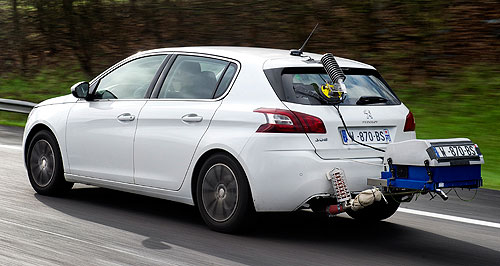Make / Model Search
News - PeugeotPSA publishes more fuel test resultsDriving reality: Apparatus carried by a vehicle allows independent technicians to accurately determine how much fuel is being used, as well as how much carbon dioxide is released into the atmosphere. Peugeot, Citroen and DS reveal real-world emissions comparisons for 30 vehiclesGallery Click to see larger images 7 Jul 2016 PEUGEOT, Citroen and DS parent company PSA has released more real-world driving emissions (RDE) test results to help rebuild public confidence in its products in the wake of the Volkswagen emissions cheat scandal that brought the previous standard test’s credibility into question. The new independent testing by Transport and Environment and France Nature Environment assesses the fuel consumption and emissions of vehicles under simulated to day-to-day driving conditions, painting a more accurate picture of a vehicle’s efficiency in the hands of a customer. The public road test incorporates a variety of driving conditions, including 25km of urban driving, 39km in rural areas and 31km on freeways. Normal passenger and luggage loads are applied, and the air-conditioning is switched on. Like the initial results revealed by PSA in March, the latest and more comprehensive round of testing shows each of the 14 Peugeot models tested to be on average 1.9 litres per 100km thirstier in RDE analysis than standard tests. Of the Peugeot range, the biggest test result difference was produced by the 1.2-litre 3008 crossover when fitted with 17-inch wheels. Although it was originally claimed to consume 4.9L/100km under standard tests, it actually used 7.6L/100km in RDE testing. The least offending model was the little 1.6L BlueHDi diesel 208 hatchback which used 4.7L/100km in RDE tests when fitted with 16-inch wheels, but 3.5L/100km according to the brochure. Citroen’s range of 11 tested models also differed on average by 1.9L/100km, with the greatest difference produced by the C4 Picasso BlueHDi 120 rolling on 17-inch wheels. In standard tests the people-mover is said to use 3.9L/100km, but RDE testing suggested 6.5L/100km. A difference of 1.5L/100km was the best the Citroen range could do, with the C4 Cactus diesel using 5.1L/100km under real world tests, compared with 3.6L/100km as stated under previous testing methods. The results for just three DS variants were published in the release, representing an average difference of 1.6L/100km between old and new tests. The smallest difference was found in the DS3 diesel, which differed by 1.4L/100km, while the petrol version had the biggest gap and 1.7L/100km. Following the Volkswagen emissions scandal, PSA says consumer confidence of traditional emissions evaluation had “collapsed”, but by establishing the more realistic RDE process and making the results available, it is restoring faith in the figures. For the analysis, the independent non-government organisations T&E and FNE take a unmodified model as it would be sold and fit a series of sensors and exhaust gas capturing chambers to trap and measure emissions when on the move. The French car-maker was the first to go public with its findings, but later this year will go further with a simulator on the Peugeot, Citroen and DS websites to allow customers to more accurately predict fuel consumption based on individual behaviour and driving habits. The calculator will be complemented by a smartphone application that owners can use to calculate and reduce their fuel consumption and emissions. PSA Group research and development executive vice president Gilles Le Borgne said the decision to publish the results was part of a strategy to regain the confidence of its customers, and that there was more work to be done. “As part of its drive to continuously provide customers with more information, the group will publish figures for another 20 models by the end of the year and introduce a simulator allowing customers to reduce their fuel consumption depending on driving conditions, thereby lowering their CO2 emissions,” he said. “In 2017, the PSA Group will move to the next level by extending measurements to pollutant emissions of nitrogen oxides (NOx) in customer driving conditions”. Previous testing was done in laboratory conditions using rolling roads, which was believed to offer a more level playing field for vehicles, but the procedure was vulnerable to so-called defeat devices and was not an accurate representation of road use.  Read more |
Click to sharePeugeot articlesResearch Peugeot Motor industry news |





















Facebook Twitter Instagram